How Big is the Sun?
- Diameter of the Sun.
- Outer Layers of the Sun.
- Mass of the Sun.
- How Hot is the Sun
How Big ?
Diameter of the Sun.
How wide do you think the Sun is, compared to familiar
places and things on the Earth?
 Let us start with some smaller Sun features. Solar granules are cellular patterns
visible in the outer layer (photosphere) of Sun, associated
with large scale vertical fluid motions at, and just below, the
photosphere. The brighter, central regions correspond to rising hotter
fluid, and the darker, narrow lanes correspond to sinking, colder
fluid. In the photo on the right, we see more than a dozen solar
granules. Each granule lasts about ten minutes.
Let us start with some smaller Sun features. Solar granules are cellular patterns
visible in the outer layer (photosphere) of Sun, associated
with large scale vertical fluid motions at, and just below, the
photosphere. The brighter, central regions correspond to rising hotter
fluid, and the darker, narrow lanes correspond to sinking, colder
fluid. In the photo on the right, we see more than a dozen solar
granules. Each granule lasts about ten minutes.
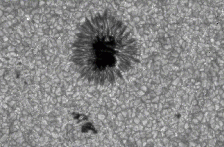 Let us continue with some larger Sun features. Now, in addition to the
solar granules, we see a Sunspot. Sunspots are dark
regions visible in the outer layer (photosphere) of the Sun, that are
cooler than their surroundings and possess strong magnetic fields. In
the photo on the right, we see a close-up view of a moderately large
sunspot. The umbra is the
darkest inner region, and the penumbra
is the lighter, ray-like,
uoter region of the sunspot. Sunspots can be small, 900 miles (about
1500 kilometers), or they can reach sizes up to 30,000 miles (about
50,000 kilometers). This moderately-sized sunspot has a
penumbral-diameter of about 10,200 miles (about 16,500 kilometers).
Let us continue with some larger Sun features. Now, in addition to the
solar granules, we see a Sunspot. Sunspots are dark
regions visible in the outer layer (photosphere) of the Sun, that are
cooler than their surroundings and possess strong magnetic fields. In
the photo on the right, we see a close-up view of a moderately large
sunspot. The umbra is the
darkest inner region, and the penumbra
is the lighter, ray-like,
uoter region of the sunspot. Sunspots can be small, 900 miles (about
1500 kilometers), or they can reach sizes up to 30,000 miles (about
50,000 kilometers). This moderately-sized sunspot has a
penumbral-diameter of about 10,200 miles (about 16,500 kilometers).
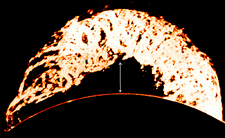 Now, continuing with an even larger Sun feature. Prominences are chromospheric
eruptions of hot gas trapped in strong magnetic fields just above the
surface of the Sun. Loop prominences near the edge of the solar disk
shows, by its shape, the magnetic structure that controls the
gas. This prominence, photographed in Hydrogen-alpha, is
affectionately referred to as the "Granddaddy" prominence. It erupted
on June 4, 1946. It extends some 124,000 miles (200,000 kilometers)
above the solar surface. The speed of its eruption was about 124 miles
per second (200 kilometers per second) which would take it across the
width of the United States in about 15 seconds.
Now, continuing with an even larger Sun feature. Prominences are chromospheric
eruptions of hot gas trapped in strong magnetic fields just above the
surface of the Sun. Loop prominences near the edge of the solar disk
shows, by its shape, the magnetic structure that controls the
gas. This prominence, photographed in Hydrogen-alpha, is
affectionately referred to as the "Granddaddy" prominence. It erupted
on June 4, 1946. It extends some 124,000 miles (200,000 kilometers)
above the solar surface. The speed of its eruption was about 124 miles
per second (200 kilometers per second) which would take it across the
width of the United States in about 15 seconds.
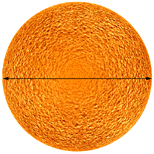 Finally, the largest Sun "feature": the Sun itself. The image at the
right is a dopplergram image of the Sun, taken by the MDI instrument on the SOHO spacecraft. This
dopplergram shows motions on the Sun's surface with areas shown bright
as those areas that are moving toward us, and areas shown dark as
those areas that are moving away. This image is the result of
averaging 30 velocity images and subtracting the contribution from the
Sun's rotation, so that what we see are the large-scale
supergranulation features.
Supergranulation is different than
the granulation features seen at the top of this page in the first
image. They are both convective regions, but they have different
shapes and sizes. Granules are characterized by vertical flows.
Supergranules, while driven vertically, can be seen primarily as large
horizontal motions. Supergranules are each about 18,6000 miles (30,000
kilometers) across. The Sun is 868,000 miles (1,400,000 kilometers)
across. Do you know how wide the Sun is compared with what we are
familiar?
Finally, the largest Sun "feature": the Sun itself. The image at the
right is a dopplergram image of the Sun, taken by the MDI instrument on the SOHO spacecraft. This
dopplergram shows motions on the Sun's surface with areas shown bright
as those areas that are moving toward us, and areas shown dark as
those areas that are moving away. This image is the result of
averaging 30 velocity images and subtracting the contribution from the
Sun's rotation, so that what we see are the large-scale
supergranulation features.
Supergranulation is different than
the granulation features seen at the top of this page in the first
image. They are both convective regions, but they have different
shapes and sizes. Granules are characterized by vertical flows.
Supergranules, while driven vertically, can be seen primarily as large
horizontal motions. Supergranules are each about 18,6000 miles (30,000
kilometers) across. The Sun is 868,000 miles (1,400,000 kilometers)
across. Do you know how wide the Sun is compared with what we are
familiar?
Outer Layers of the Sun.
How thick do you think the outer layers of the Sun are, compared
to familiar places and things on the Earth?
 The image at the right is an adaptation of a drawing to scale (1) of
the outer layers of the Sun. The photosphere, shown as an
orange vertical line, is the region where sunspots are formed. The less
dense and turbulent
chromosphere is a rapidly-changing filamentary structure
that is seen during eclipses as a bright red ring around the Sun. The
intensely active transition region,
illustrated by the vertical yellow line, was first observed in detail by Skylab in the late
1970s. Spicules
extend the chromosphere into the corona as pointed waves. Prominences and the corona reach far into
interplanetary space, and are much too large for the scale of this
picture.
The image at the right is an adaptation of a drawing to scale (1) of
the outer layers of the Sun. The photosphere, shown as an
orange vertical line, is the region where sunspots are formed. The less
dense and turbulent
chromosphere is a rapidly-changing filamentary structure
that is seen during eclipses as a bright red ring around the Sun. The
intensely active transition region,
illustrated by the vertical yellow line, was first observed in detail by Skylab in the late
1970s. Spicules
extend the chromosphere into the corona as pointed waves. Prominences and the corona reach far into
interplanetary space, and are much too large for the scale of this
picture.
Let us start with the photosphere.
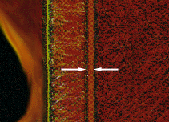 The orange vertical line marked by the two arrows is a to-scale drawing of
the solar photosphere.
Do you know how thick the photosphere of the Sun is, compared with what
we are familiar?
The orange vertical line marked by the two arrows is a to-scale drawing of
the solar photosphere.
Do you know how thick the photosphere of the Sun is, compared with what
we are familiar?
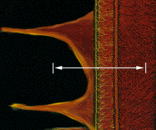 The width spanned by the long arrow is a to-scale drawing of the solar
outer layers: (Photosphere + Chromosphere + Transition region +
Spicules). Plus a little bit of the interior Sun and a little bit
of the Corona. Do you know how thick the outer layers of the
Sun are, compared with what we are familiar?
The width spanned by the long arrow is a to-scale drawing of the solar
outer layers: (Photosphere + Chromosphere + Transition region +
Spicules). Plus a little bit of the interior Sun and a little bit
of the Corona. Do you know how thick the outer layers of the
Sun are, compared with what we are familiar?
Reference:
(1) Eddy, John, A New Sun: The Solar Results From Skylab, NASA
SP-402, 1979, pg. 36
Mass of the Sun.
How massive do you think the Sun is, compared with the Earth?You can probably guess that the Sun is very massive, compared with the Earth. It is so massive, in fact, that directly comparing an Earth-like object against the Sun quickly makes one's mind become dizzy!
Instead, let us imagine that the Sun is on the scale of the largest land mammals on the Earth: the African elephants. When baby African elephants are born they weigh a a few hundred pounds and grow to a weight of several thousand pounds.
For this exercise, assume that our African elephant weighs 3300 pounds or 1500 kilograms. What object compares to our African elephant with the same proportion that the Earth and the Sun compare with each other?
Are you having a hard time imagining it? Let us say that the objects whose masses that we want to compare to our African elephant are: a Spider Monkey, a Tabby Cat, and a Wood Frog Tadpole. Take a look at the images below.
How Hot ?
How hot do you think the Sun is, compared with the temperatures of familiar things on Earth?
You can probably guess that the Sun is very hot, compared with familiar things on the Earth. We will use the same technique that we used for the mass comparisons (above), because directly comparing temperatures of what we are familiar with on the Earth, to the temperatures of the Sun, will quickly make one's mind become dizzy!
When we ask how hot is the Sun we have to specify which part of the Sun, because the Sun's temperature is different in different places. Let us start with the Sun's photosphere.
Photospheric Temperature of the Sun.
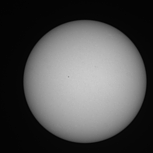
The photosphere is the layer located closest to the Sun's surface, and when viewed in white light, such as the picture shown on the right, the photosphere corresponds to the solar surface. Each square centimeter of the solar surface emits as much light as a 6000 Watt lamp. The temperature of the photosphere is about 5800 K. How hot is 5800 degrees Kelvin? Water boils at about 373 degrees Kelvin, therefore, the surface of the Sun is about sixteen times hotter than boiling water. Can you imagine sixteen times? Try the following comparison.
 Imagine that the Sun's photospheric temperature is on the same scale
as the mass of a normal-sized human male, say about 180 pounds (82
kilograms). What object is one-sixteenth the mass of our man?
Imagine that the Sun's photospheric temperature is on the same scale
as the mass of a normal-sized human male, say about 180 pounds (82
kilograms). What object is one-sixteenth the mass of our man?
Are you having a hard time imagining it? Let us say that the object whose mass that we want to compare to our Man is: a Cat, a Baseball, and a Pencil. Take a look at the images below.



The proportion of the mass of one these objects compared to the mass of our man is the same one-sixteenth proportion that the temperature of water boiling is to the temperature of the Sun's photosphere.

|
|
Image Credits
- Granulation and Sunspot Image. 14 June 1994. G-Band. Source: Kiepenheuer/Uppsala/Lockheed (P. Brandt, G.Simon, G. Scharmer, D. Shine) HAO A-003. From http://www2.hao.ucar.edu/Education/Sun/sunspot-and-granulation
- Granddaddy Image. 4 June 1946. H-Alpha. Source: High Altitude Observatory. From http://www2.hao.ucar.edu/Education/Sun/grand-daddy-prominence
- Dopplergram Image. 13 January 1996. Source: SOI/MDI/SOHO. From http://soi.stanford.edu/results/ave_30min.html
- African Elephant Images. Source: The Foutch Virtual Zoo. http://home.sprynet.com/sprynet/jfoutc01/elephant.html
- Spider Monkey Image. Source: Heather's Spider Monkey Page. http://www.cdmnet.com/heather/pets/spider.html
- Tabby Cat Image. Source: Kelly Hall's Cat Image Archive.
- Wood Frogs Tadpole Image. Source: Vernal Pool Wood Frogs Page.
- Solar White Light Image. Source: Mees Solar Observatory, Institute for Astronomy, University of Hawaii. http://www.solar.ifa.hawaii.edu/



